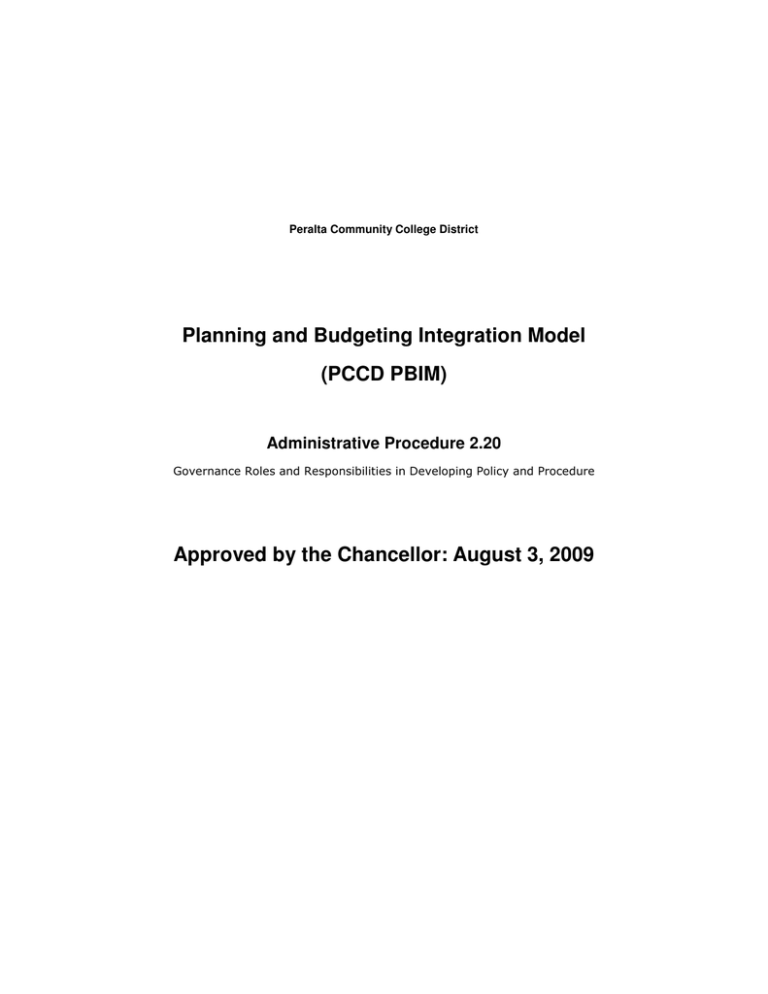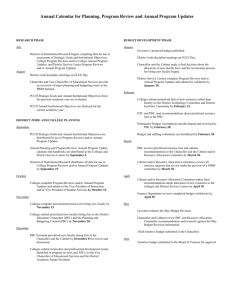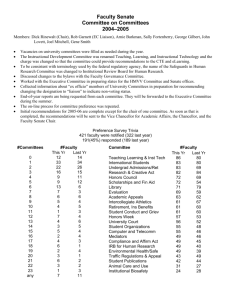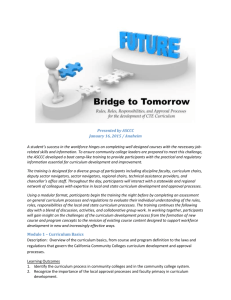Planning and Budgeting Integration Model (PCCD PBIM)
advertisement

Peralta Community College District Planning and Budgeting Integration Model (PCCD PBIM) Administrative Procedure 2.20 Governance Roles and Responsibilities in Developing Policy and Procedure Approved by the Chancellor: August 3, 2009 Peralta Community College District Administrative Procedure 2.20 I. Introduction This document describes the Peralta Community College District’s Planning and Budgeting Integration Model (PBIM). The following elements constitute the components of effective planning and budgeting integration that the Chancellor and the Planning and Budgeting Council must ensure are enacted within the policies and procedures of the district. Background In January 2009, The Chancellor convened a representative group of stakeholders – the Chancellor’s Working Group (CWG) – to study the issues and recommend options for improving the functioning of the district-wide advisory and decision-making process. The chancellor requested that the CWG recommend improvements to: Streamline the process for developing recommendations on planning and budgeting; Ensure effective shared governance participation; and Deliver thoughtful, data-driven recommendations. The CWG included the four Academic Senate presidents, four representatives of the Peralta Federation of Teachers, two Classified employee representatives, and four administrators. Guiding Principles The CWG established the following guiding principles: 1. Educational planning and needs should be the foundation of all decision-making. 2. College planning should be the primary source for determining shared governance recommendations. The role of district-wide committees and processes is to provide uniform data, assure consistency, and to encourage and promote coordination. Colleges are the primary source because they are closest to student needs and have educational expertise. 3. There needs to be a clear flow of communication between committees so that the development of recommendations is transparent and logical. 4. The Planning and Budgeting Council (PBC) has authority to make a recommendation to the chancellor and to make recommendations on initiatives proposed by the Chancellor. As per existing policies and procedures, the Chancellor and Board provide a response to advisory and constituency bodies if the recommendations are not adopted or are substantively modified. 5. All constituencies have the right to make recommendations directly to the Chancellor and Board. 6. There needs to be a clear path from recommendations to consideration in the decisionmaking cycle. 7. All decisions and minutes shall be documented and publicized widely, using all available means. This ensures effective communication to colleges and constituencies. 1 Peralta Community College District Administrative Procedure 2.20 Purpose and Need The PBIM implements the Strategic Plan mission. It is intended to promote the highest levels of success for students by providing a supportive framework for college and districtwide planning. The Planning and Budgeting Integration process (PBI) has been developed to implement a structured advisory process leading to decision-making. The PBI is consistent with AB 1725 in which the Chancellor has final authority for making administrative decisions and for making recommendations for Board action. The PBI Model is the official and standard process for developing, reviewing and recommending major decisions of district-wide relevance. The PBI Model is based on the use of consistent planning templates, activities and data to ensure transparent and predictable advisory process leading to decision-making. These common parameters are needed to promote coordination and collaboration within a district of four comprehensive colleges within a small geographic area. To leverage resources to support student access and success, the PBI provides processes to resolve issues between the colleges and district service centers, and between and among the colleges in the case of duplicative programs or unproductive competition. One Year Test of PBI Model The CWG proposes that the process outlined in this document be implemented from the beginning of the Fall term 2009 through the 2009-2010 academic. At the end of the year period, the process will be reviewed and evaluated, and any needed improvements put forward for review and adoption. Organization Working in partnership with the district office, the colleges have the primary responsibility for developing educational and resource plans to meet the needs of students. PCCD relies upon its strategic planning processes as the foundation for integrating planning and budgeting. Strategic planning includes the Peralta Strategic Plan and planning for education, facilities, information technology, human resources, marketing and fiscal resources. PCCD clearly defines and follows its guidelines and processes for planning and budget integration The PBIM does not supercede the right of constituencies to make recommendations. The PBC would use the “Shared Agreement Decision Model” on page 6. Accountability PCCD must have in place a system that has appropriate accountability mechanisms to ensure the integrity and credibility of planning and budgeting integration. College plans and budgets must be approved through the colleges’ shared governance before being addressed in the PCCD PBI Model. Support for Effectiveness The district will provide support for the PBI. This includes providing appropriate technical support (e.g., research, policy) and logistics and minutes. The goal is to have fewer, more highly supported action meetings at key decision-making milestones, rather than more frequent discussion-oriented sessions. An important support for effectiveness is to institute an annual review of district and college implementation successes and challenges, i.e., an assessment of whether previous year plans are being acted upon. 2 Peralta Community College District Administrative Procedure 2.20 For transparency, the PBIM committees will take minutes and publish these in a timely fashion. The district will ensure the efficiency of the committee process so that committee members can balance committee work and their regular duties. Release time and other strategies should be considered to support the participation by classified staff and by both instructional and student support service faculty. Terms Planning and Budgeting Integration Model (PBIM) The district wide shared governance process for integrating college planning and linking planning and budgeting. Planning and Budgeting Council (PBC) The overall integrating committee within the PBIM Shared Agreement When all committee members provide some level of support for a recommendation. (See “Shared Agreement Decision Model” below for detail) II. Process Overview The Planning-Budgeting Integration Model is presented in this section organized as follows: Annual Decision-Making Milestones College Planning District Subject Matter Committees: Education, Technology, Facilities Planning and Budgeting Council Routing of Proposals Shared Agreement Decision Model Annual Decision-Making Milestones There will be an annual calendar for each step in the advisory process leading to decisionmaking. This provides a clear structure and timeline by which the annual planning and budgeting integration process takes place. (See narrative in Appendix 2 and graphic in Appendix 3.) College Planning College planning is the foundation of the PBI as the colleges are closest to the educational needs of students. As the first element of the PBI, the colleges conduct periodic program reviews, prepare annual unit plans, and develop annual educational and resource plan priorities. The colleges integrate the results of their “subject-matter” committees into college planning, e.g., technology committees, curriculum committees, facilities committees, etc. During periodic master planning and during annual institutional planning, the colleges develop plans addressing: instructional and student services programs; staffing priorities; fiscal priorities; IT and equipment; facilities; and marketing. 3 Peralta Community College District Administrative Procedure 2.20 District Subject-Matter Committees: Education, Technology, Facilities The role of the three proposed district subject matter committees is to support the colleges in coordinating their efforts and resolving issues. The committees also provide subject matter expertise in their respective areas by including college representatives with relevant knowledge, responsibility, and experience. The committees are responsible for communicating with their counter-part committees at the colleges (including possible cross-membership). The committees should have cross-membership with the PBC. The committees are charged with developing district-wide recommendations that best serve students and the community using evidence-based processes and criteria. Therefore the committees will work toward consensus solutions that are based on the results of these processes and criteria and the “shared agreement” decision model as defined on page 6. Each decision is labeled as “shared agreement” or “unresolved issue.” The committees will identify unresolved issues to be addressed by the PBC. Role in the Advisory Process: The subject matter committees make the official recommendation to the Planning and Budgeting Council in their respective areas. The committees will indicate the status of recommendations: Shared Agreement: The committees will indicate which recommendations have achieved “shared agreement” among committee members (as defined on page 6). These decisions are considered to reflect agreement across the colleges and are not expected to be revisited substantively by the PBC. Rather the PBC evaluates proposed priorities as a set and recommends ways to integrate, prioritize and fund them. Unresolved Issues (aka “Tough Decisions”): The committees will indicate where there are outstanding issues requiring PBC action. Planning and Budgeting Council The PBC shall have the authority to make recommendations to the chancellor and shall receive a response from the chancellor before the chancellor pursues any significant course of action. The committee shall also receive draft policy initiatives and considerations from the chancellor and the board and make recommendations on those before any significant action is taken by the chancellor. The PBC recommends integrated educational and resource priorities to the Chancellor. The PBC makes recommendations on Board policies and policies and decisions initiated by the Chancellor. For unresolved issues, the PBC recommends resolutions for any issue where there is not agreement, i.e., issues between the colleges and district offices, between or among the colleges, or any other set of parties in disagreement. For shared agreement items, the PBC performs the following functions: (1) Affirms consistency with strategic and educational plans; (2) recommends a coordinated planning approach across education, facilities, IT, fiscal, etc., and across colleges and initiatives; (3) recommends a prioritization of plans across subject areas and colleges; (4) identifies funding approaches to support the priorities. The PBC is responsible for providing oversight on the implementation of the Strategic Plan. The PBC also ensures accountability for follow-through on recommendations; the PBC will track their recommendations and determine which of two results occurred: 1) the recommendation was implemented including any modifications or 2) the recommendation was not implemented and the reasons for it not being implemented. The PBC also ensures accountability for follow-through on process steps: Did constituencies, colleges, district service centers, committees, etc., perform the agreed upon steps in the process. Staffing Co-Chairs: 1 Faculty, 1 Administrator: collaboratively set the agenda with the process manager. 4 Peralta Community College District Administrative Procedure 2.20 Process Manager (non-voting): Associate Vice Chancellor for Research and Planning (AVC): facilitation, agenda and process prep, decision-tools, report coordination Note-taker/report writer The AVC as process manager would provide overall support for the PBC. The AVC has access to the relevant educational data and planning materials. The process manager would be the facilitator of the PBC sessions. Process Accountability The PBC will follow up on agreements: Did constituencies, colleges, district service centers, committees, etc., perform the agreed upon steps, for example: 1) reporting back to constituencies/obtaining responses; 2) using the agreed-upon planning methods and parameters. PBC Role and Expectations The PBC is charged with using a district wide viewpoint of what is best for the organization as a whole. The PBC should avoid using the old logic of members’ taking a narrow perspective of “protecting the college”. There needs to be consistency of membership to ensure the ability to function as a team in making tough decisions. Therefore, alternates are not allowed. Decisions will continue to be made if members are absent and they cannot challenge decisions made in their absence. If a member misses three sessions, the PBC will ask the appointing group to name a replacement, but the appointing group can only do this once during a term to avoid a loss of continuity and efficiency. The initial term of membership will be two years to allow the system to be developed and run effectively before a new slate of members is installed. This will allow continuity and the development of a collaborative practice. (This can be reviewed at the 1-year review point.) Start with a retreat to review the Chancellor’s and Board’s goals at the beginning of the year. This will help ensure a common direction and focus across the committees. Routing of Proposals The planning-budgeting integration (PBI) model provides opportunities for all ideas to be considered and improved through dialog through the appropriate process. For example, ideas emanating from the Board of Trustees, the Chancellor or district service centers are valuable options for consideration through the PBI shared governance process. Routing such proposals through the PBI model yields better results by: Providing additional scrutiny and testing of the proposal by the professionals who will be involved in implementation; Aligning the proposal to related initiatives to avoid duplication and identify opportunities for coordination; Building more widespread understanding of the proposal; Developing buy-in and ownership by inviting the responsible planning bodies to refine and develop the proposal; Avoiding a sense of micro-management or top-down decision-making by involving the appropriate people in the advisory process. Routing Procedures Any party making a proposal (or a third party learning of a proposal) shall request that the matter be referred to a college and/or district-wide committee and any other relevant processes. The referral shall be made to the college or district-wide committee that covers 5 Peralta Community College District Administrative Procedure 2.20 the subject area in question. The referral shall include the planning committees organizationally closest to the unit most likely to be affected (for example, a proposal to establish a new educational program at a given college should be referred to the educational planning committee of that college). There can be referrals to more than one committee or process. Shared Agreement Decision Model The recommended decision model has three key elements: 1. All decisions are documented: Every recommendation will be documented in detail and forwarded to the Chancellor. 2. Primary Decision Rule is “Shared Agreement”: The PBC is charged with developing districtwide recommendations that best serve students and the community using evidence-based processes and criteria. Therefore, it recommended that the PBC work toward solutions that are based on the results of such agreed-upon processes and criteria and the “shared agreement” decision model. Shared agreement is achieved when all members of the group rate a proposal as A, B or C: A: Unqualified support B: Acceptable – best of the options we have C: Can live with the decision – not especially enthusiastic but the process was followed and all viewpoints received a fair hearing. If all members do not indicate A, B, or C the group can continue to refine the proposal if there is sufficient time to do so to arrive at shared agreement. Shared agreement can also be achieved if a majority of the group indicate A, B, or C, and the remaining members indicate: D: Do not fully agree with the recommendation but feel the process was followed; need to have my viewpoint included in the documentation as a minority report 3. Voting is the Back-up Process: If shared agreement cannot be reached within the time constraints of the planning-budgeting cycle, the PBC will vote on the issue. However, voting will not be used to achieve a decision based on a majority of votes, but rather as a method of recording committee members’ assessment of proposals. The full record of the vote including any alternative viewpoints will be documented and sent to the Chancellor. III. College Planning Enhancements Each college is responsible for its planning and shared governance processes. With this in mind, the CWG recommends that each college conduct a process to assess, strengthen and streamline their local governance processes. This would allow the colleges to ensure a solid foundation for planning decisions that will move through the district-wide PBIM process. Such a review would also provide an opportunity for the colleges to consider changes that might help to align their efforts with the PBIM. IV. Review and Update The Chancellor’s Working Group will review the effectiveness of the implementation of this document after one year. 6 Peralta Community College District Administrative Procedure 2.20 Appendix 1: Subject Matter Committee Charge Template The District [subject matter committee] is charged with developing a set of integrated district recommendations on matters in its subject-matter areas (see Appendix 5). Specifically, the [subject matter committee] is to conduct the following: Provide feedback to the colleges Provide technical review of the college priorities Ensure consistency between college requests and existing approved plans (i.e., subjectmatter plans, district-wide Strategic plans, etc.) Identify opportunities for college-to-college collaboration where resource sharing could be useful. Annual Areas of Focus Each year, specific areas of focus or topics may be identified to be addressed by the Committee. These focus areas will come out of the annual retreat and can reflect priorities of the chancellor or board. Areas of Responsibility See appendix 5 for a list of the topics within the committee’s area of responsibility. Support for Coordination and Collaboration The [subject matter committee]’s overarching role is to support collaboration and coordination between and among the colleges and district offices for the benefit of students. The committee will play a facilitative role to identify win-win collaborative opportunities. The committee will also support the success of individual college initiatives by providing technical feedback and suggestions on how best to achieve the college’s goals. In keeping with this facilitative and supportive role, the [subject matter committee] will not comment upon or recommend changes to College requests that only impact the college and are consistent with district-wide agreements and plans. Conversely, the [subject matter committee] only has authority to comment upon or recommend changes to requests where there are significant opportunities for coordination (to benefit students, to achieve significant cost-savings, to reduce duplication); clear inconsistencies with previously adopted plans or agreements; or an opportunity to improve the request from a technical perspective. Specific Charges and Milestones The [subject matter committee] will achieve the following milestones to support the overall district-wide coordinated planning and budgeting integration model. Due Date September 15 November 15 Deliverable Schedule of Meeting Topics for the Academic Year Integrated recommendations for hiring decisions February 15 Integrated recommendations for other decisions January – April 15 May 15 Provide feedback to colleges and PBC Report on “lessons learned” and accomplishments and priority topics to be addressed the following year. 7 Peralta Community College District Administrative Procedure 2.20 Appendix 2: Annual Milestones Phase 1: Assessment and Research Phase 3: Budget Development Winter/Spring Term January According to their respective planning calendars, the colleges initiate planning activities in winter or spring. The initial planning activities vary between the colleges regarding the specific timing of events, but the four colleges use common planning models. Specifically, the colleges use a common unit-planning template. The focus of this phase of work is to review institutional research results and the implementation status of prior unit plans. August Chancellor and Vice Chancellor, Education, provide overview of major planning and budgeting issues at Fall flex day. Governor’s proposed budget published Informational memorandums on the governor’s budget proposal to all constituent groups (board of trustees, academic senate, budget advisory committee, faculty union, classified unions); SMT meet to review proposed budget. PBC meets to review the governor’s proposed budget and begins to develop budget assumptions. Subject matter committee meetings. February Phase 2: College and District-wide Planning Review colleges’ actual FTES, review college/district expenditures for the first half of the fiscal year. Prepare estimate of spring/intercession FTES and expenditures. Chancellor approves targeted FTES to realize growth and over cap funding. September Propose board of trustees’ budget workshop (February or March). Colleges’ budget priorities submitted to district office. There is a retreat to initiate the annual planningbudgeting process, including a canvass of critical budget and planning issues and any common directions or parameters for the coming year. College Councils and/or educational committees review status of prior educational master plans, program reviews, and unit plans and identify preliminary areas of focus for future planning. District service centers review status of prior institutional reviews and unit plans and identify preliminary areas of focus for future planning. The Planning-Budgeting Council and subject matter committees hold initial meetings. District office begins preparation of preliminary budget allocation. PBC and subject-matter committees make recommendations on non-hiring priorities. PBC and subject-matter committees work together with colleges to finalize integrated recommendations. March Initial proposals submitted to chancellor for the district budget. Review status of budget development with the academic senate and faculty union. Academic senate submits recommendation on budget process. October College Councils (or educational committees) and District service centers review district wide planning and budget guidelines and modify/adapt to fit circumstances. College VP’s and District Vice Chancellors prepare templates to update existing accelerated program review/unit planning and distribute to instructional, student service and administrative programs. Units update unit plans. These include program and service initiatives, and resource requests (faculty, staffing, professional development, equipment, facilities) April Budget proposals reviewed by budget advisory committee. May Discuss carry-over fund priorities and colleges submission of justification PBC and subject matter committee meetings November Colleges review recommendations from the college community, including faculty and staff hires, and statutory cost increases based on Educational Master Plan priorities. PBC and subject-matter committees review compiled college and service center requests to identify any areas of potential collaboration or overlap between colleges, or between colleges and service centers. PBC and subject-matter committees recommend hiring priorities to the Chancellor. Governor presents May revise to budget (May 15). Draft tentative budget submitted to chancellor June Tentative budget submitted to board of trustees at last June meeting (California Code of Regulations, section 589305[a]). July 8 Legislature approves and governor signs state budget by Jul 1. California Community Colleges State Chancellor’s budget workshop in Sacramento. Informational memorandums issued on proposed budget revenues to all constituent groups (board of trustees, academic senates, faculty union, and classified unions). Peralta Community College District Colleges meet with academic senates, faculty union, and classified unions on budget priorities. Colleges’ revised budget priorities submitted to chancellor. Approved tentative budget input into financial accounting system August Preliminary adopted budget available August 15 for chancellor’s review. Comply with Title 5, section 58301 by publishing dates, time and locations where the public can review proposed adopted budget (budget must be available at least three days prior to public hearing). Adopted budget available for public review at the district office, each college library, and the offices of each college president. September Board of trustees holds public hearing and final budget is presented for approval (on or before September 15) [California Code of Regulations, section 58305 (c)]. Completed annual financial report and adopted budget to be submitted by September 30th to the State Chancellor’s Office, with a copy filed with the County of Alameda Office of Education [California Code of Regulations, section 58035 (d)]. In following this planning-budgeting development calendar, it is further proposed first to provide each college with a base budget which would include funding for fixed costs and funding determined necessary to meet FTES goals for the academic year. This funding would be available by July 1st. If the state chancellor’s office in any given fiscal year makes cuts in funding or provides additional funding, this could affect the base budget. Second, beyond providing a base budget for each college, the proposal is to determine annually the availability of discretionary monies that could be divided among the colleges. The distribution of these discretionary funds would be based on priorities set in the educational master plans (i.e., faculty positions, classified positions, funds for new program start up) and determined through a review process wherein the district-wide educational master planning committee and the district budget advisory committee would make recommendations to the Strategic Management Team with a final decision by the chancellor on the allocation of the discretionary funds. Administrative Procedure 2.20 Appendix 3: Annual Milestones Jan - May Sep - Nov Dec - May Sep 1 - INITIAL DATA REVIEW & INITIAL DISCUSSIONS 2 - COLLEGES DEVELOP PRIORITIES 3 - DISTRICT WIDE INTEGRATION 4 - BUDGET DEVELOPMENT BOARD APPROVAL Board of Trustees Appendix 4: PBIM Flow and Responsibilities Peralta Community College District Administrative Procedure 2.20 Draft Initiatives Chancellor / SMT Draft Initiatives Integrated Planning and Budget Priorities District Planning and Budgeting Council Charge Staffing and Support The PBC shall have the authority to make recommendations to the chancellor and shall receive a response from the chancellor before the chancellor pursues any significant course of action. The committee shall also receive draft policy initiatives and considerations from the chancellor and the board and make recommendations on those before any significant action is taken by the chancellor. Co-Chairs: 1 Faculty, 1 Administrator Process Manager (nonvoting): agenda and process prep, facilitation, decisiontools, report coordination Note-taker/report writer Recommendation Accountability Process Accountability The PBC is responsible for providing oversight on the implementation of the Strategic Plan. The PBC also ensures accountability for follow-through on recommendations; the PBC will track their recommendations and determine which of two results occurred: 1) the recommendation was implemented including any modifications or 2) the recommendation was not implemented and the reasons for it not being implemented. The PBC also ensures accountability for follow-through on process steps: Did constituencies, colleges, district service centers, committees, etc., perform the agreed upon steps in the process. Integrated Priorities and Unresolved Issues District Technology Committee Responsibilities: Web site PROMPT Passport Smart classroom (technology aspects) Catalog (technology aspect) Technology related HR recommendations District Education Committee District Facilities Committee Responsibilities: Educational planning Marketing / Outreach Program planning Student Services Staffing priorities Catalog Academic calendar Education related HR recommendations Responsibilities: New, modernization, rehab of facilities / Measure A Infrastructure Maintenance Facilities master planning Safety and emergency preparedness Facilities related HR recommendations College Education & Resource Priorities Instruction / Service Goals Berkeley City College College of Alameda Staffing Priorities Fiscal Priorities IT and Equipment Facilities Laney College Merritt College Board of Trustees Peralta5: Community College District Appendix PBIM Committee Memberships Administrative Procedure 2.20 Draft Initiatives Chancellor / SMT District Wide Perspective The PBC is charged with maintaining a district-wide perspective. In aggregate, there shall be roughly equal college representation on the PBC. Draft Initiatives Integrated Planning and Budget Priorities District Planning and Budgeting Council Faculty - 8 Classified - 3 Faculty leadership at each college (academic Senate and PFT) mutually agree on a process for selecting representatives. (2 Faculty per college) 1 Classified Senate 1 Representative from 1021 1 selected by 39 (if 39 chooses not to participate, classified senate and 1021 choose 1 jointly) District Technology Committee Students – 1 Administrators - 7 Student government presidents’ council determines representative 4 from colleges (1 president) 2 at large (Chancellor’s choice) 1 Chair (VC, Finance) At least 1 each from the subject matter committees; at least one from each college. District Education Committee District Facilities Committee Tri-Chair: Administrator Co-Chair: Administrator Co-Chair: Administrator Tri-Chair: Faculty Co-Chair: Faculty Co-Chair: Faculty Tri-Chair: Classified College President Director, Technology Services (1) College technology reps (4) District distance education coordinator (1) Library faculty member (1) Facilities rep (smart classrooms) SLO coordinator (to address technology issues to support SLOs) Web coordinator College Researcher College Academic Senate Presidents (4) Faculty at large (1 per college) (4) College President (1) Vice Presidents of Student Services (4) Vice Presidents of Instruction (4) Classified representatives (4) PFT President College President (1 - Admin) Risk manager (1 - Admin) College business officers (4 - Admin) Facilities committee reps (4 – Faculty) District safety reps (1 – Class; 1 – Faculty) Vice Chancellor, GS (1 – Admin) Director, Facilities and Operations (1 – Admin) Custodial rep (1 – Class) District IT rep (1 – Class) Facilities Planning & Development Manager



